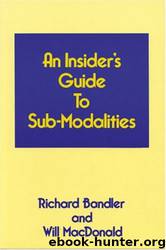An Insiders Guide to Sub-Modalities by Richard Bandler

Author:Richard Bandler
Language: eng
Format: mobi
Publisher: No Publisher
Published: 1982-05-08T23:00:00+00:00
EXERCISE: THE SWISH PATTERN
In threes. Person C acts as a resource for A and B.
Step 1. Person A identifies something he would like to change. When some particular event takes place, he gets a feeling that causes him to behave in ways he does not like.
Step 2. A closes his eyes and sees what he would be seeing if he were there in the event. Notice whether this produces the feeling. If not, pick something else. If it does produce the feeling, interrupt the pattern to enable A to clear his screen.
Step 3. B instructs A to make a big, bright, square picture of what he would see if he were there. Be sure A has a border around the picture. B then instructs A to make the picture brighter and notices, as he brightens the image, if his feelings become more intense. If not, check with A and explore alternative sub-modalities to find a suitable mechanism. If they do intensify, interrupt the pattern to get rid of those unpleasant feelings.
Step 4. B instructs A to make a picture in which he sees himself as if he had already made the change. Question A as to whether or not he likes the feelings generated by that image. B and C calibrate to As response.
Step 5. A, with his eyes open, is instructed by B in the manner in which the transition is to be made.
"In the first image, you saw what you saw at the time the event was occurring. In the second image, you saw yourself behaving in a way that was different, in a way that you liked. Shrink the picture in which you see yourself behaving the way you like until it is a little dark picture. Then take the first image, the one with the border around it, and put the little one in the corner. The big picture is bright and the little one is dark. Then let the big picture slowly begin to get dark while the little one gets big and bright, bigger and brighter until it completely covers the other image. First picture is so dark it disappears and all you see is the second one. Then stop making pictures and open your eyes as a way to clear your screen. Do that one time."
Step 6. Check to be sure A understood the instructions and was able to carry them out.
Step 7. B and C watch closely as A repeats the swish fives times fast, taking no longer that it takes to say 'whooossssh' to make the transition. B and C are watching, calibrating to As responses to see if he achieves the intensity of the resource state he reached in Step 4.
Step 8. Pattern interrupt. Then test by having A look at the image that produced the feelings he had when he first identified the change he wanted to make.
Step 9. Future pace by asking A to close his eyes and see what he would see if this were going to happen again.
Download
This site does not store any files on its server. We only index and link to content provided by other sites. Please contact the content providers to delete copyright contents if any and email us, we'll remove relevant links or contents immediately.
Waking Up by Sam Harris(2389)
Everything in Its Place by Oliver Sacks(1444)
Musicophilia by Oliver Sacks(1238)
This Is Your Brain on Music by Daniel J. Levitin(1153)
Oliver Sacks by Oliver Sacks(1141)
The Shallows: What the Internet Is Doing to Our Brains by Nicholas Carr(1005)
The Shallows by Carr Nicholas(985)
The Brain That Changes Itself by Norman Doidge(947)
THE MASTER AND HIS EMISSARY by Iain McGilchrist(906)
Cockpit Confidential by Patrick Smith(898)
Brain on Fire: My Month of Madness by Susannah Cahalan(804)
How the Mind Works by Steven Pinker(780)
Seeing Voices: A Journey Into the World of the Deaf by Sacks Oliver(746)
Self Comes to Mind by Antonio Damasio(726)
The Master and His Emissary by Iain McGilchrist(715)
The Perfectionism Workbook: Proven Strategies to End Procrastination, Accept Yourself, and Achieve Your Goals by Taylor Newendorp(679)
Touching a Nerve by Patricia Churchland(678)
The Brain That Changes Itself: Stories of Personal Triumph from the Frontiers of Brain Science by Doidge Norman(662)
NLP: Dark Psychology - Secret Methods of Neuro Linguistic Programming to Master Influence Over Anyone and Getting What You Want (Persuasion, How to Analyze People) by R.J. Anderson(640)
